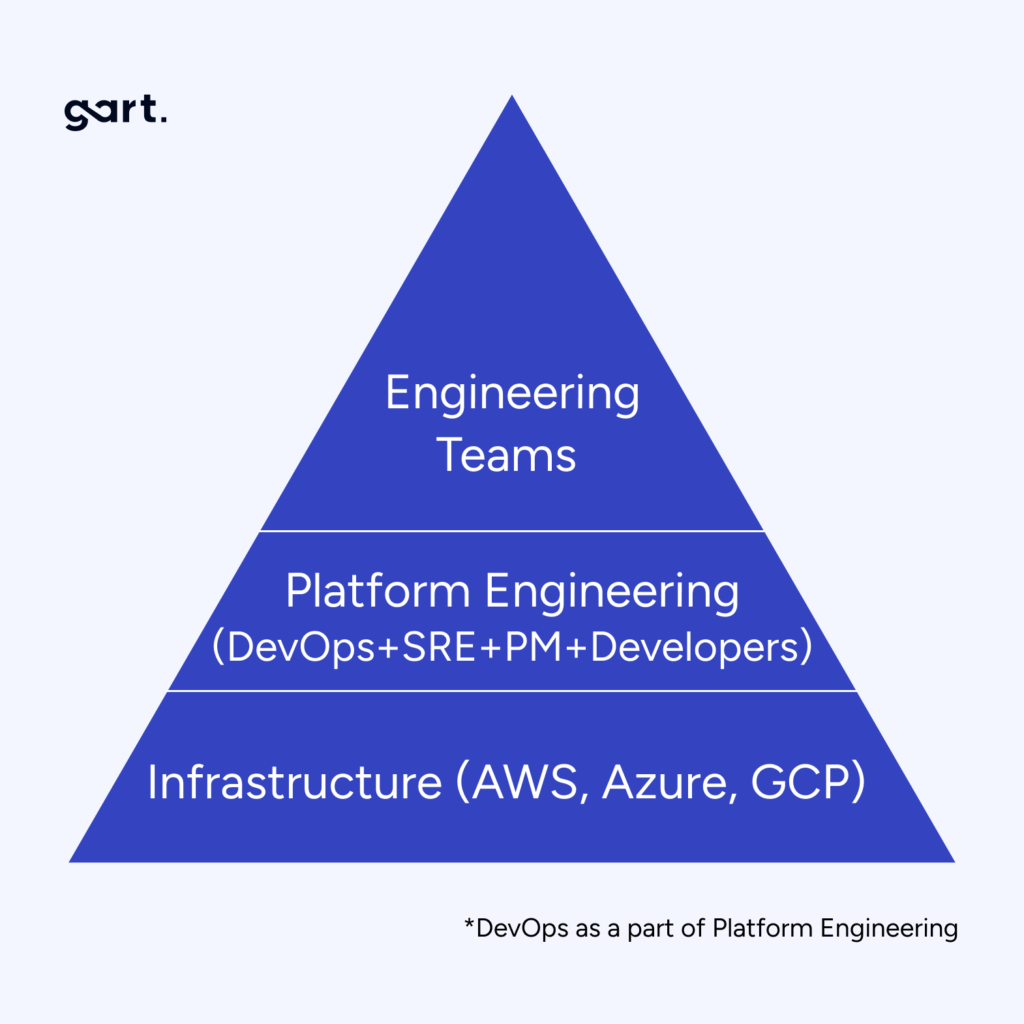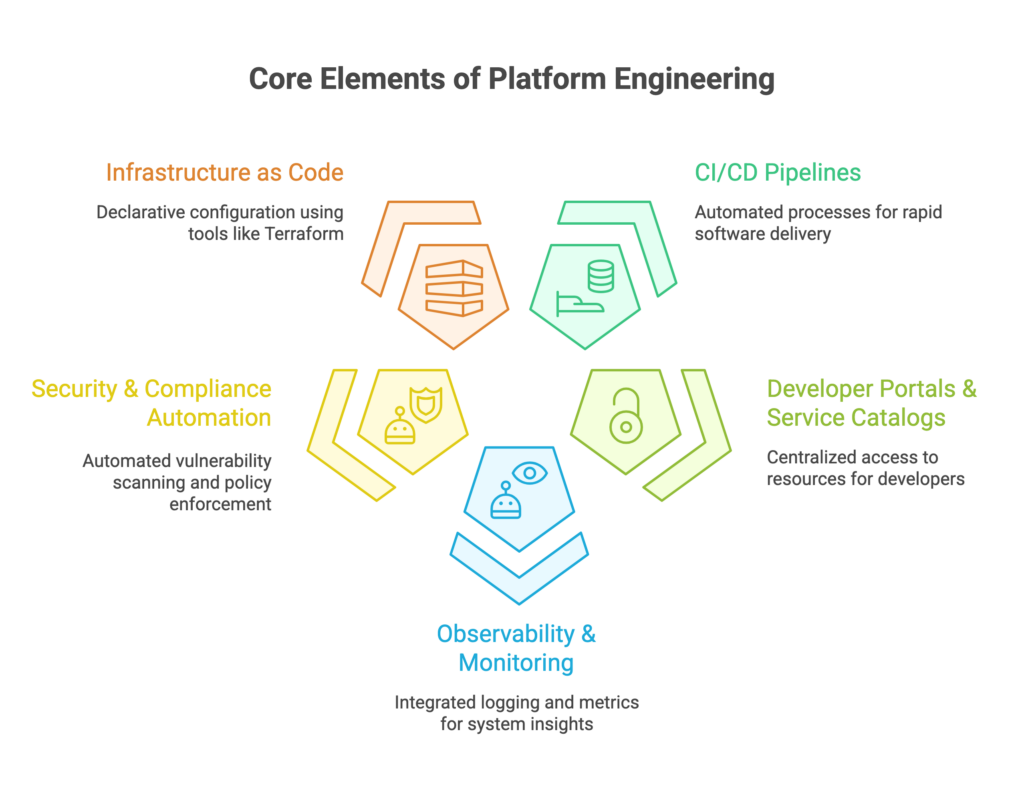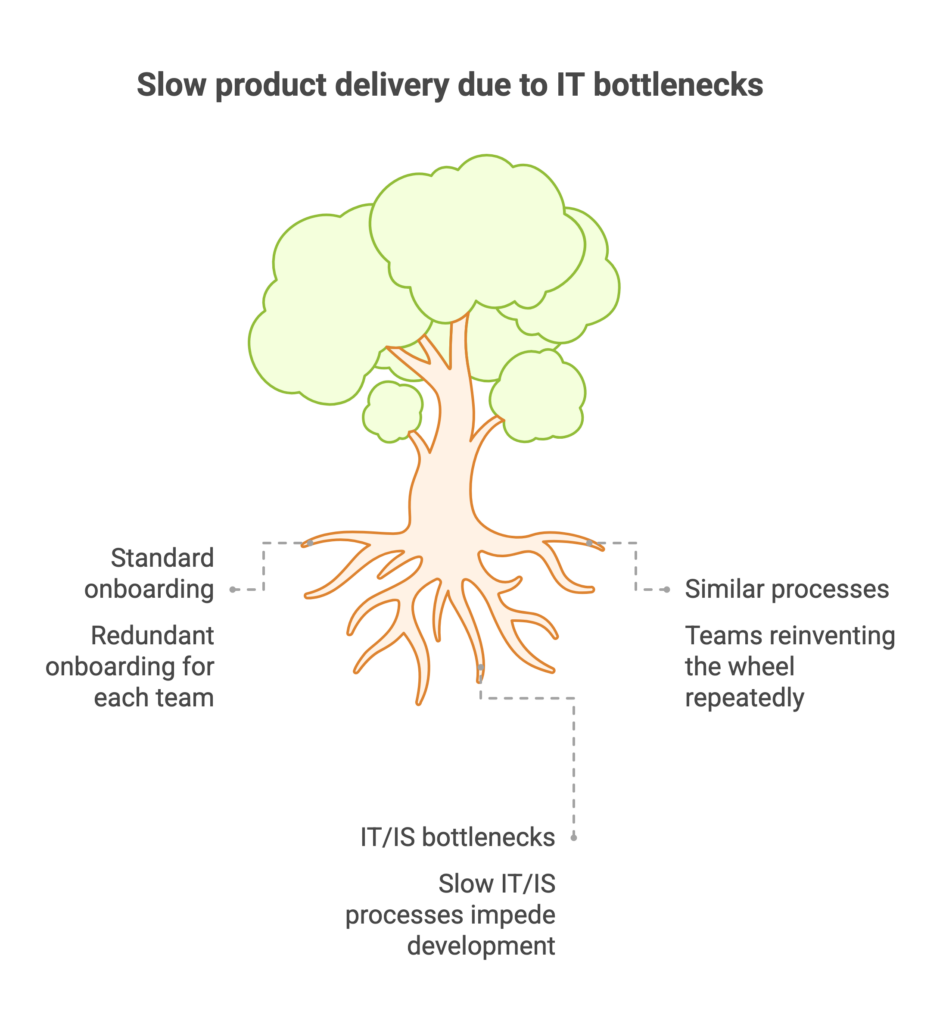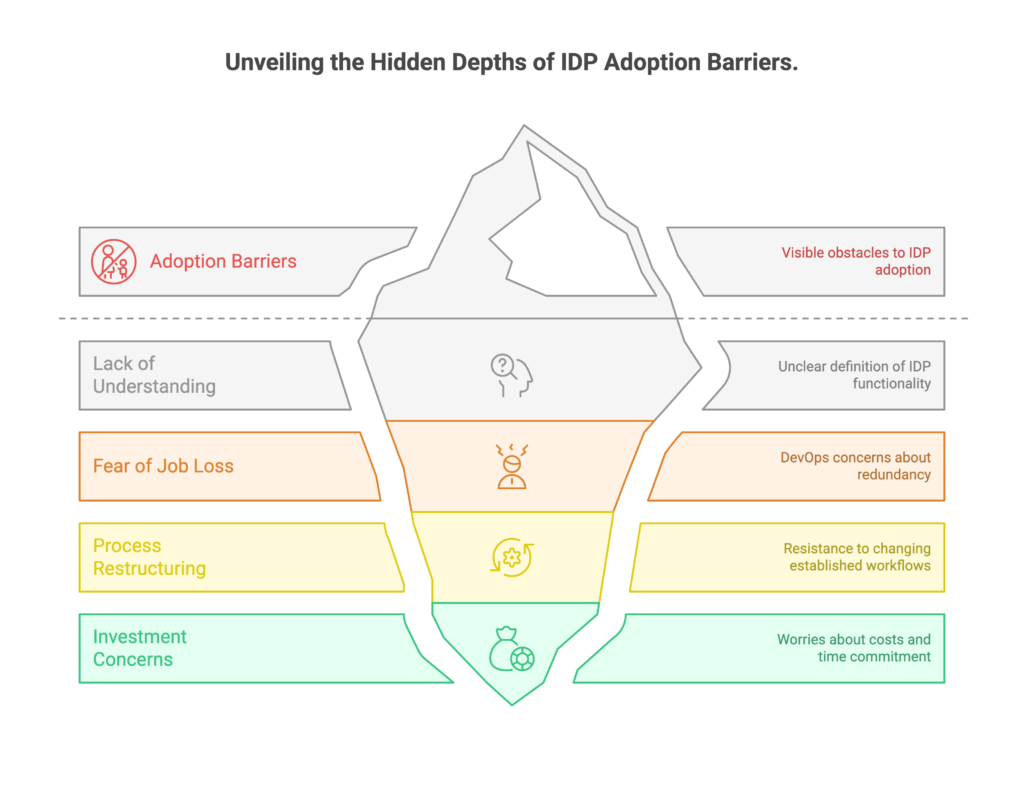- What is Platform Engineering?
- Key Components of Platform Engineering
- Development Efficiency
- Platform Engineering in the Cloud-Native Era
- Platform Engineering and Internal Development Platform (IDP)
- The Genesis of Internal Development Platforms
- Implementation Features of Internal Development Platforms
- Why Platform Engineering Is Trending
- Real-World Examples of Platform Engineering in Action
- Platform Engineering Tools & Frameworks
- Barriers to Adoption and Development of Internal Development Platform (IDP)
- Implementation Timeline and Effectiveness Evaluation
- Platform Engineering vs. DevOps and SRE: Differences in Scope, Focus, and Goals
- How Platform Engineering Compares to DevOps and Cloud Engineering
- Responsibilities of Platform Engineering
- Future of Platform Engineering: 2025 and Beyond
- Key Takeaways from the Article:
Platform Engineering is one of the top technology trends of 2024. Gartner estimates that by 2026, 80% of development companies will have internal platform services and teams to improve development efficiency.
What is Platform Engineering?

It is the process of designing and building platforms that provide infrastructure, tools, and services to support various applications and services. The main goal of platform engineering is to create a powerful and versatile platform that can support various application development and operation processes.
The platform provides developers, operators, and other stakeholders with a user-friendly interface and set of tools to simplify and accelerate the process of application development, deployment, and maintenance.
Key Components of Platform Engineering
Successful platform engineering combines technical infrastructure, automation, and developer experience improvements. Common components include:

- CI/CD Pipelines – Automated build, test, and deployment processes for faster delivery.
- Developer Portals & Service Catalogs – Centralized access to APIs, documentation, and reusable components.
- Observability & Monitoring – Logging, metrics, and tracing integrated into the platform.
- Security & Compliance Automation – Built-in vulnerability scanning and policy enforcement.
- Infrastructure as Code (IaC) – Declarative configuration using tools like Terraform or Pulumi.
Development Efficiency
The adoption of Agile, DevOps, and TeamFirst approaches, along with the rapid development of cloud and deployment tools, has led to explosive growth in software development across all segments of the economy. Businesses began to actively increase in-house development in an attempt to improve their own efficiency and occupy new market niches.
A typical development team is cross-functional and includes up to 15 people of different roles – from product manager and developers to QA and DevOps. This composition of specialists allows the team to achieve high autonomy and a high degree of responsibility for the product, which significantly reduces time-to-market.
It is noteworthy that it is undesirable to involve more than 15 people in teams: research results show that in this case, it becomes more difficult to build communications within the team, participants start to “cluster” by communication nodes, and trust between them decreases. This inevitably affects the performance of the entire team.
Technical specialists and businesses, as a rule, face typical problems inherent in teams regardless of their tasks and sphere of activity:
- Development efficiency directly depends on how much time a team devotes to developing software functionality that is valuable to the business. At the same time, teams have mandatory activities that have nothing to do with creating business value: onboarding new employees, setting up monitoring services for the product, building CI/CD pipelines. The team usually spends a lot of time and resources on all these activities, distracting them from development. At the same time, the allowable amount of cognitive load teams have is limited (primarily due to the limit of team members).
- It is important for business that time-to-market of developed solutions and functions be minimal. But in practice, the development team is dependent on specialists from other departments: it is difficult to achieve full autonomy in delivery and maintain high efficiency, as the complexity of software and the conditions of its production and operation are constantly growing.
- Development teams have a lot of routine by default, which often not only affects the team’s productivity in terms of product delivery (resulting in delays in releases), but also reduces the quality of delivered solutions. If the problem of routine is unresolved, you can get a situation with constant overtime and consequent drop in morale, burnout, and apathy. All of these have significant negative consequences for the product and the business.
The key task is to rid technicians of routine, artificial constraints and dependencies.
Streamline your DevOps with Gart Solutions – Let’s build a scalable platform together. Get in touch today!
Platform Engineering in the Cloud-Native Era
Cloud-native development has made platform engineering essential for modern software delivery. Key considerations include:
- Kubernetes Orchestration – Managing scalable workloads and microservices.
- GitOps Workflows – Declarative deployments with automated rollbacks.
- Multi-Cloud Interoperability – Avoiding vendor lock-in through portable infrastructure design.
- Serverless Integration – Supporting event-driven architectures for rapid feature deployment.
Platform Engineering and Internal Development Platform (IDP)
Platform Engineering is a methodology for organizing development teams and the tools around them, which allows removing unnecessary non-core workload from development teams, thus increasing their productivity in delivering business value.
One example of the platform approach is the creation of an Internal Development Platform (IDP), through which the development team can solve all non-core issues in a self-service mode – from requesting infrastructure and environments to accessing Observability services, necessary development tools, and utilizing typical build and deployment pipelines.
Internal Development Platform (IDP) serves as a one-stop-shop platform for developers:
- Maximizes Developer Experience;
- Provides a single point of entry, simplifying onboarding;
- Reduces the cognitive load for development teams, thereby increasing their productivity.
Thus, the better and more fully implemented the back-end platform is, the higher the efficiency of development teams.
Let’s take a closer look at the implementation of the platform approach using IDP as an example.
The Genesis of Internal Development Platforms
The trend of creating Internal Development Platforms (IDPs) is relatively new, but the industry has been moving towards them for quite some time.
Early Signs of the Need for IDPs

Even during the early stages of the digital transformation trend (2012-2015), three key points became apparent:
- Teams within a company go through the same onboarding process: This includes gaining access to tools and resources for building and deploying code, and so on.
- Teams use similar CI/CD processes for building and deploying products, as well as identical Observability techniques. Moreover, many teams solve the same architectural problems, such as creating a fault-tolerant PostgreSQL or developing Stateless microservices.
- Development speed is often slowed down by IT and Information Security (IS) departments. These departments became bottlenecks on the path to product delivery. While development teams were able to adapt to rapid changes and deployments, IT and IS departments often lagged behind. Many operations in these departments were manual, and processes were slow and not scalable.
The Need for a Solution
Companies needed to minimize this duplication of work and bypass these limitations without compromising security. The solution was the idea of consolidating all best architectural practices, configuration templates, embedding IS requirements into the infrastructure deployment workflow, and automating the allocation of development tools, with subsequent provision of all of the above using the “as a service” (aaS) model.
The Birth of IDPs
Thus, internal platforms began to emerge, and development teams gained a single portal through which they could request everything they needed to work without months of configuration and approvals. This could include virtual machines, Kubernetes clusters, databases, creating repositories in GitLab, deploying repositories, and so on.
Simplify your DevOps – Explore our platform engineering solutions. Talk to our team today!
Implementation Features of Internal Development Platforms
Today, almost all large companies are either considering or already using IDPs.
In the enterprise segment, IDP platforms are often built on the basis of cloud orchestrators (HP CSA, VMware vRA, OpenStack, etc.), which provide an IT service “constructor” and a wide stack of plugins for quick creation of self-service portals with a service catalog. As a rule, companies in the enterprise segment are assisted in this by integrators who have the necessary competencies.
At the same time, many companies create development platforms from scratch, without using ready-made solutions. This is usually done by companies with a high level of development culture who have a clear idea of what they want to get from the platform and are willing to invest significant resources in its creation and support. This allows them to integrate their own custom-built infrastructure services (Observability, IaM, etc.), CI/CD tools, and other solutions into the IDP.
In other words, IDPs in such companies are specifically tailored to the internal development business processes.
Why Platform Engineering Is Trending
Platform Engineering has become a trend because the challenges it addresses have become widespread and the benefits of its implementation are clear.
The positive outcomes of using Platform Engineering include:
Alignment of the technology stack across teams: The use of the same services and tools by different teams, available in the IDP, allows for increased efficiency of cross-team work, minimizes “shadow IT”, and reduces “competency silos” in which individual specialists and even teams operate.
Reduction of technology sprawl: Building an IDP allows for the development of a unified set of tools used in the company. This makes it possible to reduce the stack by eliminating unnecessary and duplicate solutions (for example, when different departments of the company use different tools with identical functionality). Moving away from technology sprawl simplifies stack support, its administration, and reduces licensing costs. At the same time, the expertise of the IDP support team for this toolkit grows, as there is no need to scatter resources on learning different products and solutions.
Knowledge Sharing: Creating an IDP platform implies developing detailed documentation that guides users through typical cases – from building a CI/CD pipeline to deployment in production. This ensures the continuity of expertise and guarantees that the team will be able to continue working with the tools even if some of the expert employees leave. The bus factor effect is minimized.
Security Enhancement: The IDP platform is essentially a single point of access to tools. This makes it possible to integrate security solutions into the “user-tool” chain – for example, to check access rights and perform approval procedures. IDP users can also use IT resources and services that have already been approved by security personnel.
Standardization and Improved Collaboration: Platform Engineering involves using a specific set of tools and frameworks. This simplifies application development and allows for the development of a clear standard for components, such as monitoring, logging, and tracing. Development teams can use ready-made components and functionalities to quickly create applications and services, which also simplifies the integration of the created solutions with each other. This relieves some of the cognitive load on development teams and increases their efficiency.
Onboarding Acceleration: The implementation of an IDP platform with a single stack and common rules for working with tools reduces the time it takes to connect new users or entire teams to the project. This is achieved through SSO mechanisms and tight integration with development tools, as well as pre-agreed rights and access from the security department.
Fast and Non-bureaucratic Resource Acquisition: Platform Engineering allows easy access to computing resources through a pre-agreed catalog of IT services (from the security and IT departments), which publishes IaaS and PaaS services adapted for the company. In this case, it takes a few minutes to get the necessary resources, not weeks.
All this allows development teams to be relieved from solving typical tasks and helps them focus on delivering value to the business.
Revolutionize your infrastructure – Discover our platform engineering services. Connect with us!
Real-World Examples of Platform Engineering in Action
Industry leaders demonstrate how platform engineering transforms development:
- Netflix – Custom internal platforms enabling self-service, monitoring, and automation for thousands of services.
- Spotify – Developed Backstage, an open-source developer portal for unified service management.
- Case Study – Gart Solutions helped a SaaS client cut infrastructure management time by 40% through a Kubernetes-based IDP with Terraform automation.
Platform Engineering Tools & Frameworks
A robust IDP relies on a well-chosen stack of tools and frameworks:
- Backstage – Developer portal framework by Spotify.
- Crossplane – Kubernetes-native infrastructure orchestration.
- ArgoCD / FluxCD – GitOps deployment automation.
- Terraform / Pulumi – Infrastructure as Code tools for repeatable environments.
- Prometheus / Grafana – Monitoring, alerting, and visualization solutions.
Barriers to Adoption and Development of Internal Development Platform (IDP)

The adoption of Platform Engineering as a core company concept can be hindered by various factors, both financial and organizational. However, the blockers are usually typical.
Lack of a clear understanding of what IDP is and how the platform should work. There is no strict definition of what an IDP platform is and how it should look like. Therefore, managers are afraid of “creating something wrong.” But in reality, there can be no standard: the IDP platform is created taking into account the company’s stack and work patterns, so projects of different companies differ. It is impossible to “create something wrong” if you do it according to the needs of your team.
Fear of having to cut staff. Often, the development of the Internal Development Platform is slowed down at the level of employees, including DevOps, who are worried that they will be left without work. But this is a misconception. The Platform Engineering concept does not imply a reduction in staff, but simply a shift in their focus to solving other tasks.
The need to restructure processes. After the implementation of the IDP platform, the teams responsible for IT infrastructure and information security may have to change their usual working procedures, which means that they will have to restructure their processes. This can be a challenge for both the IT team and information security, as well as for the management, which is afraid of potential risks. But in practice, with proper preparation and desire, the transition to a new methodology of work is smooth and seamless.
The need for investment and the length of the journey. Implementing Platform Engineering and developing an Internal Development Platform is not a one-day task. Such innovations require regular investments and allocation of resources from the business. However, the increase in the frequency of releases, the reduction of errors and the increase in development productivity justify any costs.
By outsourcing the development of the IDP platform, the company can mitigate some of the shortcomings and accelerate the adoption of the Platform Engineering concept.
Implementation Timeline and Effectiveness Evaluation
The implementation of an IDP platform is a continuous journey. Even after restructuring internal processes, building a self-service portal, and moving away from a “technology zoo,” it is important to continue developing the platform, updating the available stack, improving the user experience, and more. Tools, market needs, and business processes change, so IDP as a product also requires regular changes.
Typically, it takes companies several years to adapt their business processes to use an IDP platform. The timeframe depends largely on the size and expertise of the team involved in building the IDP platform, as well as the chosen implementation approach – building on a ready-made solution or developing from scratch.
It is difficult to directly assess the cost-effectiveness of implementing such projects. Therefore, conceptually, when determining the rationality of investments, several criteria are taken into account.
Ratio of developers to DevOps engineers. For example, if before the implementation of the IDP platform, 10 DevOps specialists were required for 10 development teams, then after the implementation of the solution, with a three-fold increase in development scale, the number of DevOps engineers will grow insignificantly – for example, to 15 people (without the platform, there would be almost a proportional growth).
Release frequency. Due to the reduction of approvals, checks, and secondary tasks, as well as the improvement of interaction between development teams, Time-to-market is also reduced. This allows increasing the number of releases without sacrificing quality and without a significant increase in the workload on developers.
Number of errors allowed. The unification of tools and technologies, as well as the ability to obtain the necessary resources without complex manipulations, allows for a significant reduction in the number of errors made during deployment.
Performance evaluation. The formalization of approaches and tools allows you to set and track metrics (both technical and business), which, in turn, will help you assess the effectiveness of changes or quickly identify bottlenecks.
Here are some additional points to consider:
- The maturity of the organization’s DevOps practices. Organizations with a more mature DevOps culture will be better equipped to adopt and use an IDP platform effectively.
- The level of support from senior management. The success of an IDP initiative depends on the level of support from senior management.
- The availability of resources. Implementing and using an IDP platform requires resources such as time, money, and people.
Overall, the implementation of an IDP platform can be a complex and challenging undertaking. However, the potential benefits can be significant, including improved developer productivity, reduced time to market, and increased software quality.
Platform Engineering vs. DevOps and SRE: Differences in Scope, Focus, and Goals
Platform engineering, DevOps, and SRE (Site Reliability Engineering) are three concepts and methodologies used in information technology to optimize software development and support processes. While they share common principles and goals, they differ in scope, scale, and primary tasks. Depending on the work context and their needs, modern companies may rely on platform engineers, DevOps engineers, and SREs to ensure the excellence of their products and services.
Scope of Responsibility:
- Platform engineering focuses on developing and building platforms to support applications.
- DevOps and SRE focus on the processes and methodologies for software development and operations.
Scale:
- Platform engineering is often geared towards creating highly scalable and flexible platforms.
- DevOps and SRE work at the level of processes and operations within a specific system scale.
Goals and Objectives:
- DevOps aims to reduce the time between software development and deployment, ensuring continuous delivery and automation of processes.
- SRE focuses on creating highly reliable systems and supporting them.
- Platform engineering aims to provide infrastructure and services as a platform to support various applications and services.
Focus of Work:
- Platform engineers concentrate on creating and maintaining an internal platform that facilitates application development and operations. They provide other developers with tools and services to accelerate the development process.
- DevOps encompasses a broader range of areas, combining development, operations, and ensuring continuous application development and improvement.
Processes and Methodologies:
- Platform engineers typically follow Agile methodologies with an emphasis on delivering results and continuous improvement. They strive to create flexible and efficient infrastructure for developers.
- DevOps covers a wider range of methodologies and processes, such as CI/CD (continuous integration and delivery), test automation, and containerization.
Area of Responsibility:
- Platform engineering focuses on the architecture and infrastructure of the internal platform.
- DevOps is responsible for integrating application development and operations.
Platform Engineering vs. SRE:
Focus of Work:
- Platform engineers focus on developing and supporting an internal platform for other developers, providing tools, services, and abstractions that facilitate application development.
- SRE is primarily responsible for ensuring the stable and reliable operation of a product or service. Their main task is to maintain high availability and quickly respond to problems in the production environment.
Culture and Methodology:
- SRE emphasizes a culture of reliability, where everyone in the team becomes responsible for the reliable operation of the system. They are often guided by the principles of “build, measure, tune” and “serve the customer.”
- Platform engineers typically follow Agile principles with an emphasis on continuous delivery and iteration.
Area of Responsibility:
- Platform engineering focuses on the architecture and infrastructure of the internal platform.
- SRE is responsible for the operational side of the product or service.
How Platform Engineering Compares to DevOps and Cloud Engineering
DevOps focuses on unifying development and operations by giving teams ownership of both application and infrastructure. However, as the complexity of applications and infrastructure grew, the cognitive load on DevOps teams became too high. Platform engineering builds on DevOps by creating a shared platform that reduces this cognitive load and standardizes processes across teams.
Cloud engineers specialize in managing cloud infrastructure, such as AWS or Azure, by setting up services and managing costs. Platform engineers, on the other hand, take these cloud services and integrate them into a broader platform that developers can use. Essentially, platform engineering adds a layer on top of cloud services, making them easier to use and more accessible to internal teams.
Key Differences: Platform Engineering vs DevOps vs SRE
| Aspect | Platform Engineering | DevOps | SRE |
| Focus | Internal platform development | Development and operations integration | System reliability and operations |
| Scale | Large-scale platforms | Specific system scale | Production environment |
| Goals | Platform for applications and services | Continuous delivery and automation | High availability and reliability |
| Processes | Agile methodologies | CI/CD, test automation, containerization | Culture of reliability, “build, measure, tune” |
| Responsibility | Platform architecture and infrastructure | Integration of development and operations | Operational side of product or service |
Responsibilities of Platform Engineering
Standardization of Tools and Practices
Platform engineers select the tools needed to deploy and run applications and ensure that they are used consistently across all teams. This includes CI/CD pipelines, cloud platforms, Kubernetes clusters, and security protocols.
Creation of an Internal Developer Platform (IDP)
This platform provides developers with a self-service portal where they can access pre-configured infrastructure and services, such as databases, Kubernetes clusters, and CI/CD pipelines. The IDP abstracts away the complexity of managing infrastructure, allowing developers to focus on coding and business logic.
Collaboration with Development Teams
Platform engineers work closely with development teams to ensure the platform meets their needs while maintaining best practices for security, compliance, and efficiency.
Continuous Development and Improvement
Like any product, the internal developer platform needs continuous updates and improvements. Platform engineers are responsible for iterating on the platform, adding new features, and ensuring it meets the evolving needs of the organization.
Key Problems Solved by Platform Engineering
- Cognitive Load on DevOps Teams: Traditional DevOps practices require teams to manage both application development and infrastructure. This increases the complexity of tasks for individual engineers, such as maintaining Kubernetes clusters, managing CI/CD pipelines, and ensuring security compliance. Platform engineering centralizes these responsibilities, reducing the mental load on DevOps teams.
- Inconsistency and Duplication: When multiple teams use different tools and configurations, it creates inconsistencies across the organization. Platform engineering solves this by standardizing the tools and environments, reducing duplicated efforts across teams.
- Scalability and Efficiency: With traditional DevOps, each team might configure and manage its infrastructure separately, leading to inefficient resource use. Platform engineering provides a shared platform that is scalable, consistent, and optimized, allowing for easier management of resources and infrastructure.
Future of Platform Engineering: 2025 and Beyond
The discipline will continue to evolve with:
- AI-Driven Platforms – Predictive scaling, automated optimizations, and intelligent troubleshooting.
- Greater Abstraction – Developers interact with higher-level services instead of raw infrastructure.
- Internal Platforms as Products – Treating the platform as a maintained and evolving product.
- Security-First Design – Automated detection, remediation, and compliance verification.

Key Takeaways from the Article:
Platform Engineering is a major technological trend that companies worldwide are actively following by creating their own IDP platforms. The methodology has become particularly popular due to the active digital transformation of businesses.
Building IDP platforms gives businesses competitive advantages in the era of digital transformation and helps them overtake competitors on the go by maximizing efficiency.
Today, companies do not need to dive into IDP platform development from scratch: they can choose ready-made solutions and partners with experience and expertise in IDP construction.
See how we can help to overcome your challenges









